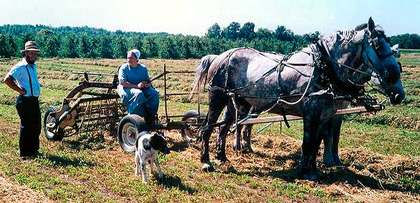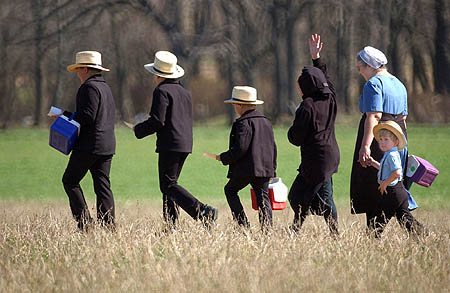Amish's total current population is about 308,000, and it doubles every 22 years. New settlements were created in Bolivia, Argentina and Canada last year.
 The total population of Amish people is about 308,000. / Reuters
The total population of Amish people is about 308,000. / Reuters
The Amish branched out last year with new settlements in Bolivia, Argentina and Canada as their numbers continued to grow and a high percentage of young people opted to remain within the religious community, which eschews many modern conveniences.
The total Amish population was only 124,000 in 1992. According to Joseph Donnermeyer, a professor of Ohio who directed part of the US census in 2010, the Amish have always grown. They double their population every 22 years.
A GROWTH OF 18%
Amish's total current population is about 308,000 and has grown about 18% over the past five years, according to an ongoing population survey by the Young Center for Anabaptist and Pietist Studies at Elizabethtown College in Pennsylvania.
Nearly two-thirds of all Amish live in three US States: Ohio, Pennsylvania and Indiana, but there are currently settlements in 31 states and three Canadian provinces.
The largest settlements are in Lancaster County, Pennsylvania, and Holmes County, Ohio, both with more than 34,000 people and more than 200 congregations, or districts, as they are known.
 The Amish bring economic value to the rural communities where they live.
The Amish bring economic value to the rural communities where they live.
ARGENTINA AND BOLIVIA
The two small South American settlements were both founded last fall after longstanding Mennonite communities in those countries reached out to North American Amish to explore affiliation, said Steven Nolt, a senior scholar at the centre who helped coordinate the population survey.
In recent years, their members in Bolivia and Argentina have faced financial problems and isolation, and the Ohio Amish ministers decided to send two families to settle there to create communities the existing Mennonites can join. They also sent teams to help with building projects.
The Bolivian community, known as Colonia Naranjita, is about 75 miles southwest of Santa Cruz, while the settlement in rural northwestern Argentina is located east of Catamarca.
North American Amish generally do not do mission work.
“AN UNUSUAL APPROACH”
"This is kind of a new and different thing and illustrates an unusual, even among the New Order Amish , Amish approach to taking in new members", Nolt said.
He explained Mennonite men in those areas have begun to grow Amish-type beards, and an Ohio Amish woman has made bonnet head coverings for the women.
The centre says Amish typically strike out and establish new communities to find quality and affordable farmland in isolated areas near other Amish, to live where there is work in specialized occupations and to resolve disputes about church leadership.
 An Amish family. / Reuters
An Amish family. / Reuters
HIGH BIRTH RATE AND PROSPEROUS COMMUNITIES
The Amish birth rate is very high. The average number of children is 6.8. Amish communities believe in natural contraceptive methods, and having many children is a blessing for them.
Additionally, only a few of them leave the community, even though they must spend some time outside their communities before they decide their future.
Donnermeyer believes both facts are the main reasons of their growth. “A simple, reasonable and transparent economy has also been an important reason.”
The Amish bring economic value to the rural communities where they live, Donnermeyer explains, because “they are prone to buy local products, have a very low unemployment rate, and rarely need social aid.”
ISOLATED FROM THE WORLD
The Amish are known for using horses and buggies for transportation, wearing traditional dress, worshipping in homes not church buildings, and speaking a German dialect. Their ranks are composed of dozens of distinct groups with different practices they allow and prohibit.
The Bible is their only source of authority, they believe in the universal priesthood, and live isolated form the world. Any contact with technology is forbidden,and most of them work within the community.
They justify their isolation and rejection of technology, with the teachings of Peter, Paul´s epistle to the Romans, and the epistles of John and James.

Las opiniones vertidas por nuestros colaboradores se realizan a nivel personal, pudiendo coincidir o no con la postura de la dirección de Protestante Digital.
Si quieres comentar o